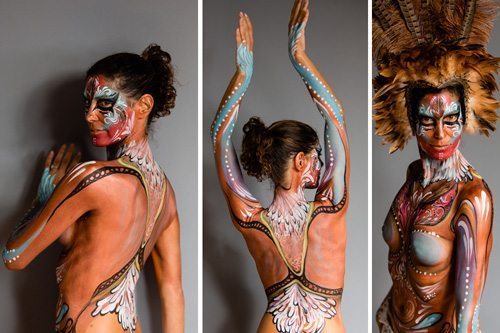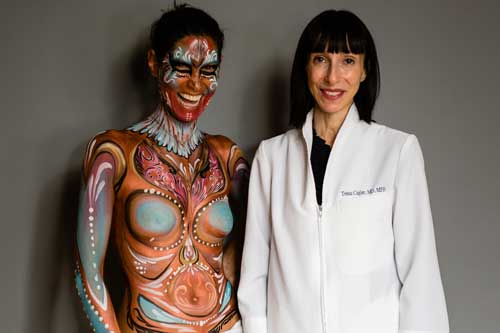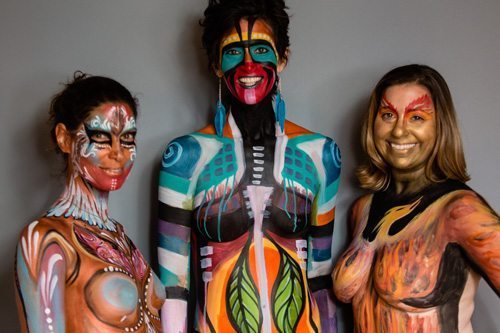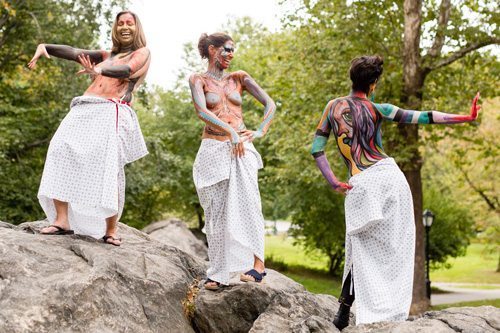Inspired Art Therapy for Breast Cancer Patients
Using body paint and portrait photography, the Breast Cancer Women's Empowerment Project helps current and former patients change the way they view their bodies.


Dana Bledsoe was seated in the Weill Cornell Breast Center smiling as a professional body-paint artist perfected the bright colors streaked along her arms. Ribbons of blue, white, red, black, and yellow extended from the tribal and feather-like pattern that decorated her entire upper body and face.
The mother of three, who has stage 4 breast cancer, usually comes to the center to see her oncologist. But on this overcast September morning, body-paint artist Avilda Whittmore-Walker transformed her into the “graceful warrior” she wished to be.
“When I looked in the mirror I thought, ‘I am a completely different being,’” says Dana, 49. “I could feel myself having more of the essence of this warrior woman, and it transformed me. It’s not how I feel every day.”
Dana was one of eight women in various stages of breast cancer treatment and survivorship who participated in the first-ever Breast Cancer Women’s Empowerment Project, a series of body-painting and photography sessions organized by survivor Marquina Iliev-Piselli, who has been treated at the center. Marquina transformed her own breast cancer experience through art and creativity, and wanted to help others do the same.
“I wanted to help people feel positive about their bodies after going through or during cancer treatment. This is a way to reclaim your body from illness,” says Marquina, 38, a book marketer, who is in remission.
In 2015, while facing an aggressive form of breast cancer called HER2-positive, she turned her chemotherapy treatments at the center into glamorous photo shoots with the help of her friend, photographer Casey Fatchett, who teamed up with Marquina again to photograph patients for this recent body-painting project. Calling it the Glam Chemo Project, Marquina wore elaborate gowns, jewelry, makeup, and wigs, all while powerful drugs were pumped into a port in her chest during the six-hour sessions. She succeeded so much in making it a positive experience that she now enjoys returning to the center to offer the same positivity to others.
“I have met other survivors who don’t want to come back to where they were treated, but this is not a place where I feel bad. I feel like I can help others and allow them to feel what they feel and move forward,” says Marquina.
Invitations for the project were sent to current and former patients of the center and also distributed to breast cancer groups throughout the tri-state area.

Faith Taraskus chose to have a rose painted on her chest, which she found to be “feminine and pretty, but strong,” and helped her feel more like herself.

Dana Bledsoe channels a “graceful warrior” through her body paint.

Jacqueline Hurley wears a medal she won as a member of the Empire Dragon Boat Team NYC, a team of breast cancer survivors, to pay tribute to the strength she has drawn from them.

Dana Bledsoe with her doctor, Dr. Tessa Cigler, a breast oncologist at NewYork-Presbyterian/Weill Cornell Medical Center.

Dana Bledsoe, Marquina Iliev-Piselli, founder of the Breast Cancer Women’s Empowerment Project, and Carrie Kreiswirth in their body paint.

Carrie Kreiswirth, Dana Bledsoe, and Marquina Iliev-Piselli strike a pose in Central Park.
Lifting Spirits
On this recent fall morning at the cancer center, the mood felt like a bridal party getting ready for a wedding. In a conference room not far from where some have received treatment, women took turns connecting their phones to speakers to play music, snacked on pastries and bagels, sipped coffee, and laughed. A few consulted Pinterest to choose their body-art design. Arms were held up not for an exam but for paintbrushes to reach underarms. Staci Akselrod, 27, who had a bright unicorn surrounded by a blue sparkled sky painted on her chest, beamed as she took a selfie while her artist, Jocelyn Goode, prepared the next color.
For Akselrod, who was preparing for a modified radical mastectomy the following week, the project was empowering. “It was a good way to mentally prepare for the changes that would come with surgery,” she says.
For others, the body-painting session and photo shoot was a welcome distraction.
“We were downright giddy,” says Jacqueline Hurley, 38, who timed a checkup with her physician at the center for that day and slipped out, fully painted, for an injection while waiting for her photograph to be taken.
Jacqueline’s chest displayed a speckled green dragon with yellow glaring eyes. She chose it as a tribute to Empire Dragon Boat Team NYC, New York City’s breast cancer survivor dragon boat racing team, of which she is a member. She credits the rowing team with helping her take her life back from cancer and giving her strength. She brought with her the gold medal her team won at a recent competition.
“As the paint was being put on, you sort of felt a mental transformation along with the physical,” says Jacqueline, a portfolio manager for an investment management firm, whose dragon was painted by artist Ralph Serrano. “I felt like I had a suit of armor on, not to protect me but to help me feel strong.”
She recalled low moments going through chemotherapy and receiving looks of pity on the street. She had shaved her head to prepare for hair loss but was struck, when looking in the mirror, to see her eyebrows and eyelashes gone.
“I didn’t think it would bother me so much to have my eyebrows fall out or realize I have no eyelashes,” Jacqueline says. “I didn’t think about how to handle that. You look in the mirror, and not fully recognizing what’s looking back at you is difficult.”
The project’s timing coincided with Jacqueline’s one-year anniversary of finishing treatment. “I felt this kind of empowerment and invincibility coming back to the center that day,” she says. “The dragon felt powerful and mystical.”
A Bonding Experience
The Breast Cancer Women’s Empowerment Project created its own sense of community, and many of the participants described it as a cathartic therapy session.
Topless and covered in body paint, they exchanged stories about treatment side effects, their families and careers. Some were preparing for or had undergone lumpectomies or mastectomies, and some were entering early menopause as a result of medications. One young woman discussed whether she would be able to have children, and another pointed out that her favorite part of chemotherapy was that she didn’t have to shave her legs anymore.
“It’s a sisterhood and a bond,” says participant Carrie Kreiswirth. “[Cancer] is a club you don’t want to be a part of, but once you are in, you are in it for life and you are given connections that feel real and helpful and positive.”
Carrie, 40, did not know what art she would choose when she arrived. As she and the artist, Ashleigh Alexandria, spoke, she blurted out “girl on fire,” referencing Katniss Everdeen, the heroine from “The Hunger Games,” whom she thought about a lot during her now-completed cancer treatment.
“That concept quickly morphed into the idea of a phoenix rising from the ashes, which I also identified with,” says Carrie, who had images of fire stretched along her arms and torso. She says she interpreted the myth of the phoenix to symbolize power, peace, and patience, which she has summoned during her own journey. She also found herself humming the Alicia Keys song “Girl on Fire” throughout the morning.
Faith Taraskus, 38, who earlier this year had a bilateral mastectomy, chose to have a rose painted on her chest with flames built into it.
“It was so feminine and pretty, but strong,” she says. “I don’t have my final implants in yet, and I’m not going to for another month and a half, so it’s been weird. I hate to say it, but at times I feel like less of a woman. I don’t have breasts right now. I have expanders [tissue expanders that make room for the final implant] and they are oddly shaped and not in the right place. Just seeing something beautiful there instead was a really helpful reminder that I am still me, with or without natural breasts.”
Dr. Tessa Cigler, a breast oncologist at NewYork-Presbyterian/Weill Cornell Medical Center, stopped by the sessions and posed for photos with some of her patients.
“A diagnosis of breast cancer and its treatment has so many implications for a woman’s body image,” says Dr. Cigler, who is also an associate professor of clinical medicine and the medical director of the Weill Cornell Breast Center. “The ability to celebrate one’s body in a positive way and to take back control is empowering. It’s just amazing to recognize the unbelievable strength and beauty of these women.”
A Celebration of Empowerment
At one point during the morning, Dana mentioned she wanted to keep her paint on all day and show her children and maybe walk the streets. Soon, a plan was in place to parade through Central Park in their body paint. A few hours later, Marquina ordered an Uber ride to take her, Dana, Carrie, and their photographer to Central Park for an outdoor photo shoot.
“The Uber driver didn’t seem fazed by us getting in the car,” Marquina says. “He just said, ‘Are you Marquina?’ and we got in.”
The women gave themselves nicknames based on their body paint — Freaky, Phoenix, and Feather — and posed near some columns and a fountain in the park. As they sat topless on a rock, a police car rolled by and Marquina says she thought, “Please don’t arrest us, please don’t arrest us.” (The shoot continued uninterrupted.)
Marquina is unsure of where the project will go next. It might become a book, a photo essay, or perhaps simply images for the women to keep as a reminder of the confidence inspired by the day.
“I wanted to create an uplifting project to help them feel good in their own skin,” says Marquina. “I got more out of this project than I ever could have imagined because of the positivity in the room and the wonderful women. Seeing each individual come out of their shell in front of a camera and reflecting this powerful version of themselves was inspiring.”
Dana found the day freeing and liberating. “It was celebrating women with cancer,” she says. “Not hiding ourselves, but celebrating ourselves no matter what scars we have or what’s been done to our bodies.”
She wore her paint the rest of the day and picked up her 11-year-old son at school and took him to tennis practice, showing off, fully painted, to the other parents. “I felt absolutely fearless.”

